Darwin Sunset
A Little Girl and the Darwin Town Burro
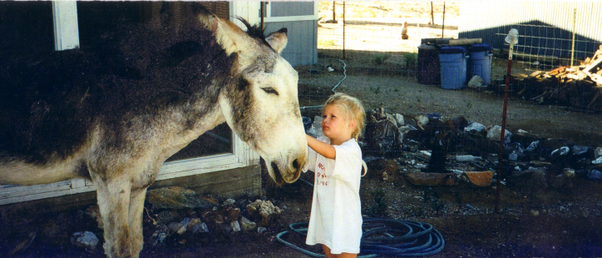
No one knew
where the Burro came from. One day she
just came clomping up the street. She
was very tame, enjoyed being around people.
She had no name, was just called Burro.
The Darwin residents took her on as a town pet and put up with her
chewing up gardens, flowers and such.
One very cold night in the middle of January they found her laying down in the road. Soon there was a crowd of people all bundled up from the cold trying to get her up. After many attempts at tugging on her, they made a sling and hoisted her up in a trailer-like affair, originally used for moving propane tanks. Covered from the cold, she was cared for a week or two, but was never able to stand again.
I can still see all those miserably cold people trying to save the Darwin town Burro.
One very cold night in the middle of January they found her laying down in the road. Soon there was a crowd of people all bundled up from the cold trying to get her up. After many attempts at tugging on her, they made a sling and hoisted her up in a trailer-like affair, originally used for moving propane tanks. Covered from the cold, she was cared for a week or two, but was never able to stand again.
I can still see all those miserably cold people trying to save the Darwin town Burro.
The Sleeping Indian Princess
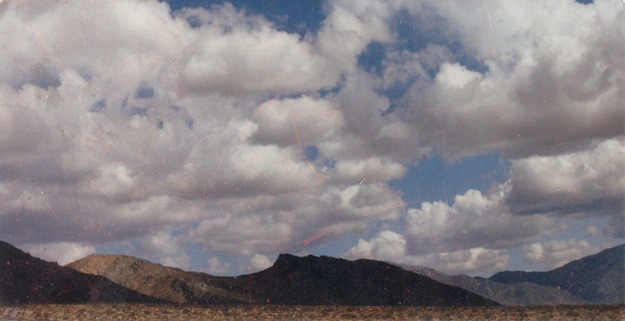
The hill in the center foreground is one of the Darwin Hills. It has the shape of a reclining female. Since Darwin’s founding over 130 years ago, it has had many descriptive names. The one we like best is “The Sleeping Indian Princess.”
Darwin's Largest Building
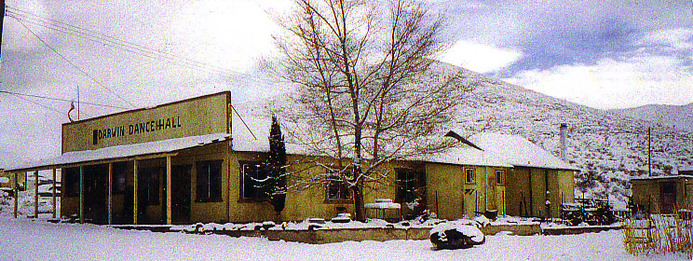
It
appears it is actually two buildings combined into one. Viewed from
the front, the left side was the Miners Union Hall; the right at some
distant time a restaurant. In the early 1950s or perhaps earlier, it
was a bar run by Alice and Bill Crossin. The building had CROSSIN’S
CORNER painted on the false front above the porch overhang. The right
side was a bar, the room to the left a gaming area. The Crossins had a
very lively trade of miners and townspeople. One story told of that
time was the Sheriff coming in the front door and announcing he was
looking for the Smith brothers. Two guys in the back of the room
quietly got up and hastily went out the back door, never to be seen
again. After changing owners a couple of times, once being used as a
pool hall, the building was renamed the Darwin Dance Hall. Since that
time, it is used by the present owner for parties, dances, social
gatherings, receptions, music events, et cetera, et cetera, et cetera. .
. .
Bottles in a Window
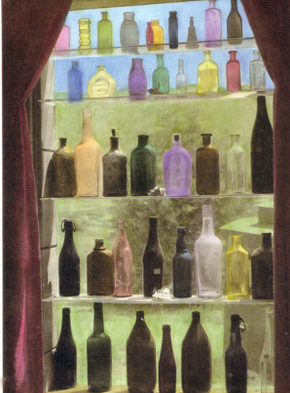
Hundreds of thousands of bottles and glass containers were, after use, discarded in the desert during the eighteen hundreds. Food, medicine, liquor, remedies, wine, chemicals, mustard and spices, to name a few, came in glass. These containers arrived from all over the world on sailing ships, or were freighted from their place of origin on this continent. Glass and pottery were the containers of choice prior to the metal can. Today collectors search for these old bottles, some of which are quite valuable. One of the favorites is clear glass which the sun has turned purple. Impurities in the old glass caused this change of color. Early towns, old mining camps, and mine diggings are some of the places where they are found.
The Mill at the Darwin Mine in Winter
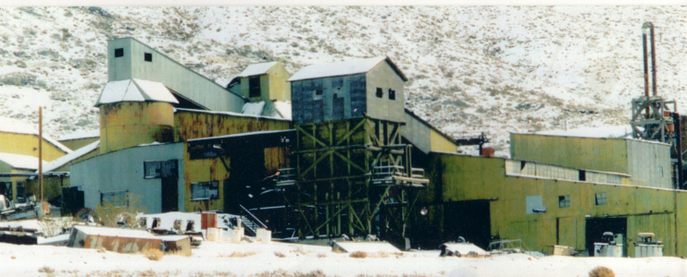
Long since dismantled, the mill was a visual study in angles. With roofs going off in different directions and at various heights it was always an interesting sight. Built on the lower southeast side of the Darwin Hills, reportedly in the 1940s, to crush and mill the ore bearing rock from the mines, so the minerals could be removed.
A Darwin Underground House
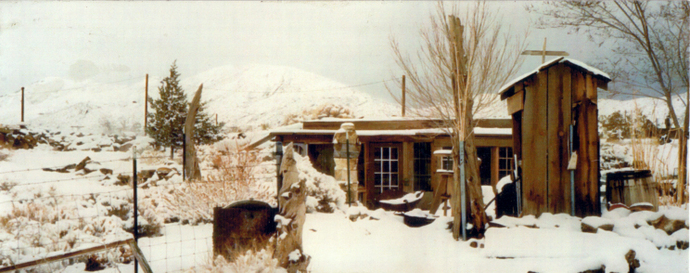
Underground homes are generally cut out of the side of a dirt bank. After excavating the size you require plus extra room for rock or concrete block inside walls, the top is covered with heavy timbers, a moisture barrier and a thick layer of dirt. Partition into rooms, add a front wall, and you have a snug, cool in summer and easy to heat home.
The Snow Covered High Sierra with Alabama Hills in Foreground
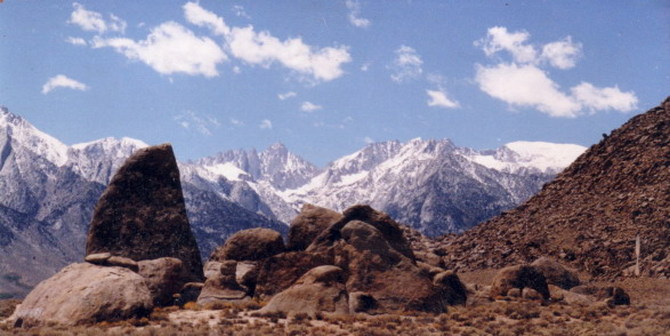
Continental United States highest peak Mount Whitney (slightly left of center), at 14,494 feet, towers over the town of Lone Pine, California. Named for Josiah Dwight Whitney, head of California Geographical Survey 1863 and 1864, devoted to the Sierra Nevada.
The honor of the first climb to the summit goes to three fishermen, Charley Begole, Johnny Lucas, and Al Johnson, on August 18, 1873. Not knowing a name for the highest peak had already been chosen, they called it Fisherman’s Peak.
The honor of the first climb to the summit goes to three fishermen, Charley Begole, Johnny Lucas, and Al Johnson, on August 18, 1873. Not knowing a name for the highest peak had already been chosen, they called it Fisherman’s Peak.
The Old Frances Black House
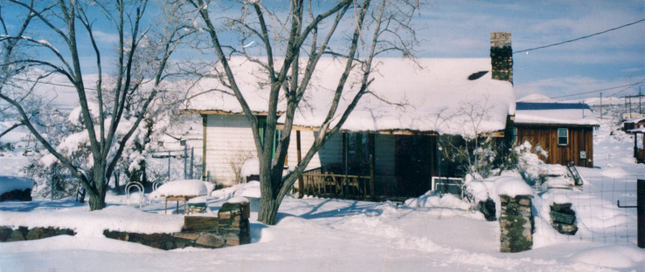
Frances came to Darwin in 1954 and lived here for almost forty years. She taught school here and was Darwin’s biggest booster. She was known over much of Southern Inyo County and called the Honorary Mayor of Darwin.
Movie Road/Alabama Hills
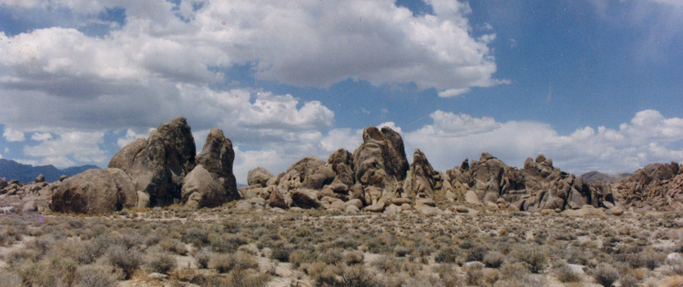
Located three miles west of Lone Pine off Whitney Portal Road is the giant boulder strewn area known as Alabama Hills. About four miles of Movie Road runs through this wonder of huge rock formations. Countless movies, TV shows and commercials have been and are still being made in these hills and the Lone Pine area. About the first movie was made in 1920, according to Dave Holland in his fine book, “On Location in Lone Pine.” The granddaddy of them all was 1939’s “Gunga Din,” with an abundance of horses, 1500 extras and even a few elephants. About 300 films have been made here. A short list of some of the stars who have acted here include Gene Autry, Gregory Peck, Errol Flynn, Bogart, Eastwood, Roy Rogers, McQueen, Fairbanks Jr., Gary Cooper, John Wayne, Glenn Ford, James Garner, Mel Gibson, and Cary Grant. And for the ladies, Anne Baxter, Linda Darnell, Susan Hayward, Dale Evans, Joan Fontaine, Ida Lupino, Jodie Foster, Laraine Day, Virginia Mayo, Maureen O’Hara, Barbara Stanwyck, and Shelley Winters.
Diaz Lake
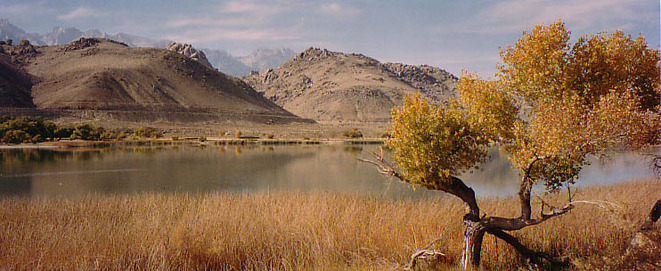
Two and a quarter miles south of Lone Pine and 35 miles west of Darwin, this lake was formed March 26, 1872 in the early morning hours. An 8.2 (estimated) earthquake centered in Lone Pine created it when land to the west and east was raised and the land between sank. Water from a small stream and newly formed springs filled this depression. This earthquake is considered the largest since exploration of the West began.
Lower Darwin Falls
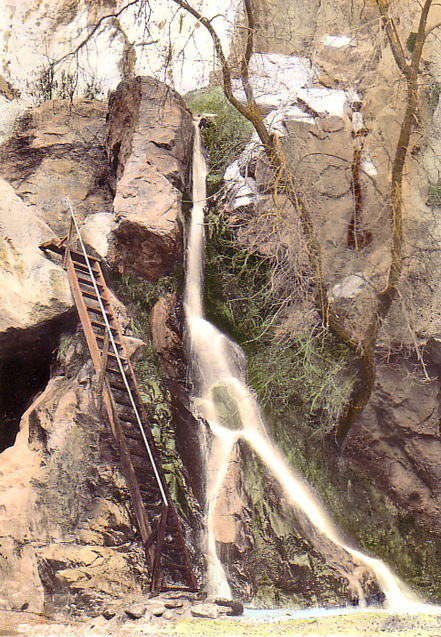
(Bonus picture)
This photo of Lower Darwin Falls was taken in the 1940s. The ladder is long gone. Nowadays it's a scary and dangerous climb to the next falls up the canyon.
(Black and white photo, hand colored by Lloyd.)
This photo of Lower Darwin Falls was taken in the 1940s. The ladder is long gone. Nowadays it's a scary and dangerous climb to the next falls up the canyon.
(Black and white photo, hand colored by Lloyd.)
